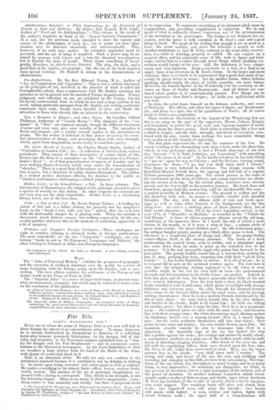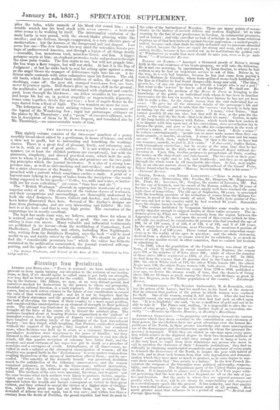$iu 3rto.
BORE'S WANDERING JEW.* Every one to whom the name of Gustave Dore is yet new will hail in these designs the advent of an extraordinary artist. To many, however, he is already familiarized by illustrations to Rabelais of a rollicking horse-play humour genuinely Rabelaisian; by the designs, full of chivalry and wizardry, to the Provencal romance published here as
fry the the Knight and the Fair Brunissende " ; and by occasional contributions to the illustrated newspapers. In the Paris Exhibition of 1855 we recollect a large picture from his hand of the Battle of the Alma, with plenty of crowd and shock in it. Dore is an abnormal artist. He will not only not conform to the established standard because it is established, but he delights in defying it : he insists upon being eccentric and extravagant as well as original. He pushes everything to its utmost limit—effect, horror, couleur locale, crowd, motion. The essence of his art is grotesque imagination, expressed with a daring to correspond. This, which is his strength, is also his betraying danger. There is no strain in Dore's imagination ; everything comes to him naturally and vividly : but there is perpetual strain
The Legend of the -Wandering Jew, Illustrated by Gustave Dort. Poem, with Prologue and Epilogue, by Pierre Dupont, Be. Translated, with Critical Remarks, by George W. Thornbury, Author of" Art and Nature at Home and Abroad," Ste. Ptiblished by Addcy and Co, in its expression. To represent everything at its intensest pitch must be exaggeration, and pervading exaggeration is vulgarism. We do not speak of what is ordinarily termed coarseness, nor of the grotesqueness of the invention or the personages. The former is not frequent nor excessive, and the latter is both essential in M. Pore's case and a good thing in itself. We speak of the feeling that enough is not as good as a feast the artist surfeits, and gives the beholder a surfeit its well. Another misfortune is, that M. Dore, contrary to the wont of his countrymen, is a child at drawing, properly so called. He can conjure up a magical effect, and his admirable sense of life, both in figure and landscape, carries him in a canter through many things which plodding correctness would bungle at for ever : still, the deficiency is very conspicuous and very injurious. From a sea-wave to a tree, or a toad to eit angel, there is no structure in M. Dore's forms. In the larger and more elaborate, there is so much to be represented that a good deal must of necessity be given better or worse ; but the smaller forms, where delicate marking should supply the place of visible quantity, are mere lumps. However, the human figures in the Wandering Jew are certainly an ad, vance on those of Jaufry and Brunissende. And all defects are condoned where 'genius is so unmistakeably present. Few things can be more impressive than Dore's designs ; he holds you spell-bound while you look.
In style, the artist bases himself on the fulness, audacity, and verve of Delacroix. His effects, and often his types of figure, are Rembrandt, ish ; and there is a spice also of the quaintness of Purer; all ,of course fused. in Pore's own originality. These wood-cut illustrations of the legend of the Wandering Jew are due to an essay on the part of the engravers, Messrs. Jahyer, Rouget, and Gauchard, to revive the great scale and vigorous manner of woodcutting about the Durer period. Each plate is something like a foot and a third in height; and the skill, strength, and finish of execution, combined with the size, render them perhaps the most remarkable things ever produced. in this branch of engraving.
The first plate represents the sin and the sentence of the Jew. He stands working at his shoemaking craft upon a boot, under the shop-sign, which, in true grotesque spirit, is just a French shop-sign of our OW11 day, lettered—" A la Bette Judaique, par Laquedem," with something about "du rime et du neuf." In his hardheartedness he has told. Christ to "get on" upon his way to Calvary ; and the Saviour, turning round, denounces the doom—" I go, but you shall tarry until I return." This figure is very deficient in elevation. The design swarms with brutalized bloated Jewish faces, the tag-rag and bob-tail of a regular Tyburn procession 1800 years ago. The crowd presses in the wake of the condemned up the steep of Calvary, and young reprobates are climbs hag the crosses at its top. In the second plate, centuries have already passed, and the Jew is still on his ceaseless journey. His hand, here and elsewhere, grasps hard the money-bag with its inexhaustible five sous— a symbol probably of Hebrew avarice. The ground is sodden and the sky drenched with rain : he passes a roadside crucifix with dreadful thoughts. The sky, with its oblique drift of rain and lurid openings, as well as some other features of the background, are the fine thing here : the rest is a striking piece of black gleamy effect, but of little worth otherwise. Plate III is the Jew's legendary arrival, in the year 1774, at "Bruxelles en Brabant," as recorded in the " Plainte du Juif Errant." A brace of obtuse pompous citizens accost the old man, wondering at the immense fleece of a beard the end of which a mule ehiums in his mouth, as if it were a wisp of hay ; a solemn circle of geese closes round ; the street children pear; the old clothesman grins ; the antique burgher guard, passing up a black alley, pause to look. The old street is a wonderful piece of design and effect. Its quaint Gothic corner-effigies thrill at the strange presence. The horns of a devil surmounting the central house seem to writhe, and. a miniature angel has come down from its niche to prick on the wretched Jew to his penance. It is the real inexorable angel who points him forward in the next plate. The gossips huddle round him at a tavern-door, ranting for him to stay, pushing him back, tempting him with their "pat de biere fraiche" : a dog howls frightfully in chorus. It is all of no use : he is in torment till he gets on the accursed journey again. The Jew here is very fine : his despairing, itching eagerness to be off, when it were paradise might he but rest for even half an hour—the preternatural strength and determination in his feeble frame--are perfect. Indeed, in both this plate and the last, the figures generally showlittle of the artist's wonted deficiencies. Now the Jew fords a river, its black-wooded banks castellated with feudal ruins, which gleam in twilight with strange fitfulness and visionary grey : the eddy beneath his charmed footstep takes shape of the Saviour fallen under his cruel cross, and the jeering, smiting executioners—Now he is in a modern French churchyard by the fire of early dawn : the same vision haunts him in his own shadow, and hurtles in the clouds ; death is all round him ; the bells are tolling for another grave ; but there is none for him—Now he is in a mountaingorge : the scattered pines are alive with the same vision, and threaten him with their scraggy arms ; the white denouncing angel, shining against the blackness, hovers over a roaring torrent—Now in a snowy alpine pass : but the rocks sculpture themselves still into that vision ; their peaks become saint and martyr; his own double frowns upon him ; the mountain crucifix unnails its arm to denounce him—Now in a shipwreck : the insatiable rage of the sea has dashed the ship like a pebble against the rocks ; her cordage and anchor fly madly about; a sea-monster swallows at a gulp one of the broken masts with its half.. dozen of shrieking clinging wretches ; other heads of the crew rise and fall with the engulphing billow, their eyes riveted upon the Jew, who, like Peter of old, walks from wave-crest to crest. Here, too, the vision pursues him in the clouds : "you shall tarry until I return." The swing, and rush, and heave of the sea, the torn and writhing surf bounding and clanging up the cliffs, are here truly astonishing. The repetition of the one vision, too, throughout so many designs and in so many forms, is very impressive ; its monotony not chargeable, we think, to any poverty of invention, but to a right perception of the subject, and of the power of iteration. In another instance Laquedem stands invulnerable amid a mediseval fortress-siege and battle, upon whose incidents M. Dore has lavished all the wealth of atrocity which a fertile imagination could suggest. Two irunkless heads still glare and clench their teeth ; two lopped-off arms still gripe the swords ; two hearts still smoke with hatred. A man, armless and legless, fights with sword between teeth ; the upper half of a cross-bowman still plies the bolts, while runnels of his blood clot round hint; a miserable wretch has his head stuck with seven arrows ; a head-andarms seems to be walking by itself. The intertangled confusion of the main battle is very grand, with the sword-blades glancing white like needles ; and the fortress, though exaggerated, is a very effective piece of medimvalism ; but the horrors of the foreground pall and disgust. Last scene but one—The Jew threads his way amid the untrodden forests perhaps of undiscovered America, and through a legion of all things deadly —crocodile, boa, monstrous toad, nameless lizard, and lion. A hippopotamus snorts at him ; an elephant protrudes tusks and proboscis through the close palm trunks. The lion starts to see, but will not grapple him; the boa wags a fiery tongue, but will not strike. At last it is the Day of Judgment ; at last he sinks back to rest his aching spine against a stone, as the angel blows the trumpet of deliverance right into his ear. A delirious smile contends with utter exhaustion upon his features. The old, old boots, which have walked their millions of miles, the rags of black stockings, come off; the poor old, cramped travel-sore feet, are bare, never to journey again. Hell-flames glare up from a deft in the ground ; the multitudes of quick and dead, intermixed with elephant and camelopard, loom through the blackness ; one fellow straddles in his pea-coat, and keeps his hat on, in perfect stupidity or impenetrable depravity ; bones come together, devils flay and tear ; a host of angels flicker in the rays darted from a flood of light. The Jew wanders no more for ever. The letterpress of this most striking volume includes a summary of the legend of the Wandering Jew ; rapid but picturesque critiques on the plates by Mr. 'Thornbury ; and a "poem" of excessive silliness, written in description of them by M. Pierre Dupont, and translated also by Mr. Thornbury,—an unaccountable waste of time.



































 Previous page
Previous page